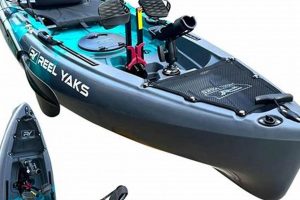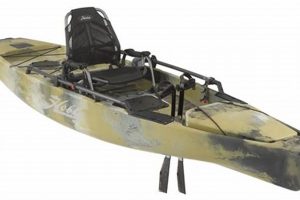Organized and accessible gear is essential for a successful kayak fishing trip. Dedicated compartments, crates, and specialized bags within a kayak keep essential equipment like lures, lines, hooks, and tools readily available while maintaining a safe and efficient fishing platform. For example, a well-designed system might include a crate behind the seat for frequently used lures and a waterproof bag under the bow for extra line and terminal tackle.
Efficient gear management contributes significantly to angler success and enjoyment on the water. Easy access to tools and tackle reduces wasted time and frustration, allowing more time for actual fishing. Furthermore, a well-organized system enhances safety by preventing loose items from shifting and potentially causing instability. While early kayak anglers relied on basic dry bags and improvised storage, the growing popularity of the sport has driven innovation in specialized storage solutions designed specifically for the unique challenges of kayak fishing.
This article will explore various approaches to outfitting a fishing kayak with optimal storage solutions, covering topics such as built-in compartments, aftermarket accessories, DIY modifications, and best practices for organizing and securing gear.
Essential Kayak Fishing Storage Tips
Optimizing limited space is crucial for efficient kayak angling. These tips offer practical guidance for maximizing storage capacity and ensuring readily accessible equipment.
Tip 1: Prioritize Frequently Used Items: Keep lures, tools, and tackle used regularly within easy reach. Consider a tackle box or tray system mounted near the seat for quick access.
Tip 2: Utilize Vertical Space: Install rod holders and vertical storage systems to keep items off the deck and maximize available space. This also reduces clutter and improves safety.
Tip 3: Employ Waterproof Storage: Protect sensitive electronics and essential gear from water damage using waterproof bags, boxes, or hatches.
Tip 4: Distribute Weight Evenly: Balance gear distribution throughout the kayak to maintain stability and prevent tipping. Avoid concentrating heavy items in one area.
Tip 5: Secure Loose Items: Use bungee cords, straps, or clips to secure gear and prevent it from shifting or falling overboard, especially in rough conditions.
Tip 6: Customize Storage Solutions: Adapt storage systems to individual needs and kayak layouts. DIY modifications or commercially available accessories can significantly enhance organization.
Tip 7: Regularly Declutter and Reorganize: Periodically assess gear and remove unnecessary items. Reorganize remaining tackle to optimize efficiency based on fishing style and target species.
Effective storage solutions contribute significantly to a more organized and enjoyable kayak fishing experience. By implementing these tips, anglers can maximize available space, improve safety, and focus on the task at hand.
These practical storage strategies form the foundation for a successful kayak fishing trip. By incorporating these tips, anglers can enhance their experience on the water and improve their chances of a successful catch.
1. Accessibility
Efficient access to tackle and gear is crucial for a productive and enjoyable kayak fishing experience. Accessibility considerations influence kayak selection, storage solutions, and overall organization strategies. Rapid retrieval of essential items, such as lures, pliers, and line cutters, directly impacts angling success and safety.
- Reach and Positioning:
Frequently used items should be positioned within easy reach, minimizing the need for excessive movement or stretching. This often involves placing tackle boxes, trays, or tool holders near the seat or within arm’s length. Reaching for a lure in a quickly accessible tray versus rummaging through a storage hatch in the bow exemplifies the importance of strategic positioning.
- Clear Organization:
A well-organized system contributes significantly to accessibility. Clearly labeled compartments, designated areas for specific items, and a logical layout minimize search time and frustration. Knowing precisely where each item is located allows for quick retrieval, particularly in dynamic fishing situations.
- Kayak Design and Layout:
The kayak’s inherent design significantly influences accessibility. Sit-on-top kayaks generally offer more readily accessible storage options compared to sit-inside models. Features like open decks, recessed trays, and strategically placed hatches contribute to efficient gear management.
- Physical Limitations:
Individual physical limitations, such as mobility or reach, should inform storage system design. Adapting storage solutions to personal needs, potentially through customized modifications, enhances accessibility and overall fishing experience. Utilizing a rotating tackle carousel, for example, improves access for anglers with limited reach.
Prioritizing accessibility in tackle storage enhances fishing efficiency, reduces wasted time searching for gear, and contributes to a safer and more enjoyable experience on the water. A well-designed system allows anglers to focus on fishing, maximizing their chances of success and minimizing potential disruptions.
2. Security
Secure storage solutions are essential in kayak fishing to prevent gear loss and maintain vessel stability. Protecting valuable equipment from theft and environmental factors, such as wind and waves, contributes significantly to a safe and productive fishing experience. Inadequate security measures can lead to financial loss, compromised safety, and disrupted fishing trips.
- Theft Prevention:
Kayaks, especially when left unattended, can be vulnerable to theft. Securely storing rods, reels, and tackle inside lockable compartments or utilizing cable locks deters opportunistic theft. While leaving a high-end rod and reel visible on an unattended kayak invites theft, securing them within a locked hatch reduces the risk significantly.
- Environmental Protection:
Protecting gear from the elements is crucial. Waterproof storage solutions, such as sealed hatches and dry bags, safeguard tackle from rain, splashes, and even submersion. A sudden wave washing over the deck might soak exposed gear, while items stored in a waterproof compartment remain protected.
- Gear Retention:
Securing loose items within the kayak prevents loss due to wind, waves, or accidental capsizing. Bungee cords, straps, and mesh netting keep tackle boxes, tools, and other equipment in place, even in rough conditions. An unsecured tackle box might slide off the deck in choppy water, while a properly secured box remains in place.
- Kayak Stability:
Properly secured gear contributes to kayak stability. Loose items shifting during paddling or maneuvering can compromise balance, increasing the risk of capsizing. A heavy tackle box sliding to one side can destabilize the kayak, whereas a securely fastened box maintains even weight distribution.
Implementing robust security measures in kayak tackle storage safeguards valuable equipment, enhances safety, and contributes to a more enjoyable and productive fishing experience. By addressing potential risks associated with theft, environmental exposure, and gear loss, anglers can focus on fishing with confidence, knowing their equipment is protected and secure.
3. Waterproofness
Waterproofness is a critical aspect of fishing kayak tackle storage, directly impacting the longevity and functionality of essential equipment. Exposure to water, whether from rain, splashes, or accidental submersion, can damage sensitive electronics, corrode metal components, and ruin tackle. Effective waterproof storage safeguards against these risks, ensuring equipment remains functional and reliable throughout the fishing trip. For example, storing electronic fish finders and GPS units in waterproof cases protects them from malfunction due to water damage. Similarly, keeping tackle and lures in waterproof containers prevents rust and maintains their effectiveness. Neglecting waterproofness can lead to costly replacements and compromise fishing success.
Several strategies contribute to maintaining waterproof integrity in kayak tackle storage. Utilizing waterproof bags, boxes, and containers provides a primary line of defense against water intrusion. Selecting kayaks with sealed hatches and compartments offers built-in protection for stored gear. Furthermore, applying waterproof sprays or coatings to tackle boxes and bags enhances their water resistance. When choosing waterproof solutions, factors like material durability, closure mechanisms, and overall construction should be considered. For instance, a high-quality dry bag with a roll-top closure offers superior protection compared to a standard zippered bag. Regularly inspecting and maintaining waterproof storage solutions, including checking for leaks or damage, ensures continued effectiveness.
Maintaining waterproofness in fishing kayak tackle storage is essential for preserving valuable equipment, ensuring functionality, and maximizing the lifespan of gear. Implementing appropriate waterproof storage solutions minimizes the risk of water damage, ultimately contributing to a more successful and enjoyable fishing experience. Failure to prioritize waterproofness can lead to equipment failure, financial loss, and compromised safety on the water. Therefore, incorporating robust waterproof practices into tackle storage strategies should be a primary consideration for any kayak angler.
4. Space Optimization
Space optimization is paramount in fishing kayak tackle storage due to the inherent limitations of kayak design. Efficient use of available space directly impacts both fishing success and overall safety. Maximizing storage capacity allows anglers to carry a wider variety of tackle and gear, increasing adaptability to changing fishing conditions and target species. Conversely, inadequate space optimization can lead to cluttered decks, hindering movement and potentially compromising stability. For example, a kayak angler targeting multiple species might need to carry various rods, reels, lures, and terminal tackle. Efficient organization allows for storage of all necessary equipment without sacrificing accessibility or safety. Without proper planning, the limited space within a kayak can quickly become disorganized and inefficient, hindering fishing performance and potentially creating safety hazards.
Several strategies contribute to effective space optimization. Utilizing vertical storage solutions, such as rod holders and tackle racks, maximizes deck space and keeps gear organized. Employing stackable storage containers and modular tackle boxes allows for efficient use of vertical space within hatches and compartments. Furthermore, choosing multi-purpose tools and minimizing redundant gear reduces overall storage requirements. For instance, a multi-tool combining pliers, cutters, and knife functions eliminates the need for three separate tools, saving valuable space. Similarly, selecting lures and tackle based on target species and anticipated fishing conditions minimizes the need for excessive gear. Careful pre-trip planning, considering target species, fishing techniques, and environmental conditions, enables anglers to pack efficiently and optimize available space effectively.
Effective space optimization is essential for successful kayak fishing. It enables anglers to carry necessary gear without compromising safety or efficiency. By employing strategic organization techniques, maximizing vertical space, and minimizing redundant equipment, anglers can transform limited kayak space into a highly functional and productive fishing platform. Failure to prioritize space optimization can hinder fishing performance, create safety hazards, and diminish the overall enjoyment of the kayak fishing experience. Therefore, understanding and implementing space optimization principles are crucial for any angler seeking to maximize their success and enjoyment on the water.
5. Weight Distribution
Weight distribution plays a crucial role in kayak stability and performance, directly influencing safety and fishing effectiveness. Proper weight distribution ensures the kayak remains balanced and maneuverable, reducing the risk of tipping and maximizing paddling efficiency. In the context of fishing kayak tackle storage, weight distribution becomes even more critical due to the added weight of gear and the dynamic nature of fishing activities. Uneven weight distribution can create instability, particularly when casting, reeling, or landing fish. For example, concentrating heavy tackle in the stern can cause the bow to rise, increasing susceptibility to wind and waves. Conversely, excessive weight in the bow can make the kayak difficult to control and prone to taking on water. A balanced load, with weight distributed evenly from bow to stern and side to side, enhances stability and maneuverability.
Several factors contribute to effective weight distribution in a fishing kayak. Heavy items, such as batteries and tackle boxes, should be positioned low in the kayak and near the center of gravity. Lighter items can be stored higher and towards the bow and stern. Distributing weight evenly across the width of the kayak also contributes to stability. When packing the kayak, consider the anticipated fishing activities and adjust weight distribution accordingly. For instance, if trolling is the primary fishing method, storing gear near the stern helps maintain proper tracking. If sight casting is planned, positioning essential tackle within easy reach near the seat optimizes efficiency. Regularly assessing and adjusting weight distribution throughout the fishing trip, particularly after landing a fish or changing fishing locations, further enhances stability and control. Neglecting weight distribution can compromise safety and hinder fishing performance, underscoring the importance of this aspect in kayak fishing.
Understanding and implementing proper weight distribution principles is essential for safe and successful kayak fishing. A balanced load maximizes stability, enhances maneuverability, and improves overall fishing efficiency. By considering factors such as item weight, storage location, and anticipated fishing activities, anglers can optimize weight distribution to enhance both safety and performance on the water. Failure to prioritize weight distribution can lead to instability, increasing the risk of capsizing and compromising fishing success. Therefore, weight distribution should be a primary consideration when planning and executing any kayak fishing trip.
Frequently Asked Questions
Addressing common queries regarding fishing kayak tackle storage provides valuable insights for anglers seeking to optimize their on-the-water experience.
Question 1: What are the most common types of kayak fishing storage solutions?
Common storage solutions include built-in compartments, aftermarket accessories like crates and bags, and do-it-yourself (DIY) modifications tailored to specific needs.
Question 2: How can waterproofness be ensured in kayak tackle storage?
Waterproofness is achieved through waterproof bags, boxes, sealed hatches, and waterproof sprays or coatings applied to storage compartments.
Question 3: What strategies maximize limited storage space in a fishing kayak?
Strategies include vertical storage solutions, stackable containers, modular tackle boxes, minimizing redundant gear, and careful pre-trip planning.
Question 4: How does weight distribution impact kayak stability and fishing performance?
Proper weight distribution, achieved by balancing heavy items low and near the center, enhances stability, maneuverability, and overall safety.
Question 5: What security measures protect against gear theft or loss?
Security measures include lockable compartments, cable locks for securing kayaks, and tethering gear to prevent loss due to wind or waves.
Question 6: How does accessibility influence tackle storage design and organization?
Prioritizing frequently used items within easy reach, using clear labeling systems, and adapting storage to individual needs enhances accessibility and efficiency.
Understanding these key aspects of kayak tackle storage allows anglers to make informed decisions regarding equipment choices and organizational strategies, ultimately leading to a safer, more efficient, and enjoyable fishing experience.
For further exploration of specific tackle storage solutions and techniques, continue to the next section detailing product reviews and recommendations.
Fishing Kayak Tackle Storage
Effective fishing kayak tackle storage is integral to a successful and enjoyable angling experience. This exploration has highlighted the critical aspects of accessibility, security, waterproofness, space optimization, and weight distribution. Each element contributes significantly to overall efficiency, safety, and the angler’s ability to focus on the task at hand. From securing valuable equipment against theft and environmental factors to maximizing limited space through strategic organization, prioritizing these elements enhances every aspect of the kayak fishing experience. Furthermore, the analysis of various storage solutions, from built-in compartments to aftermarket accessories and DIY modifications, provides a comprehensive understanding of the available options and their respective benefits.
Strategic tackle storage transforms a kayak from a simple vessel into a highly effective fishing platform. By embracing the principles discussed, anglers can elevate their fishing performance, enhance safety on the water, and maximize their enjoyment of the sport. Continual refinement of tackle storage strategies, based on individual needs and evolving fishing techniques, remains a key element in pursuing excellence in kayak angling. The pursuit of optimal tackle storage represents an ongoing investment in the overall kayak fishing experience, contributing to increased success and a deeper appreciation for the sport.






